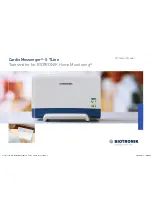
properly. If batteries are good and installed correctly, and the receiver still does not beep, call Customer
Support for additional information.
• Press any button on the remote transmitter. Does the containment transmitter beep? If not, check the
remote transmitter battery for proper installation and that it is good. If batteries are good and installed
properly, but the containment transmitter does not beep, call Customer Support for more information.
If your dog does not appear to receive or feel the correction
• Refer to the section "Testing the Correction" to ensure that the receiver collar is functioning properly.
• Trim dog's hair in the area of the probes to insure proper contact with skin.
• If trimming your dog's hair does not help, then try using the long contact probes.
If dog ignores correction and runs through system
• Reinforce all training procedures.
• Try increasing the width of the signal field.
• Try using the "Shock Only" mode on the containment transmitter.
• Check batteries in the receiver collar, weak batteries can weaken correction.
• Call 1-800-732-2677 and inquire about the Stubborn Dog Receiver.
Inspect wire
If the containment transmitter and receiver collar check out good on above tests, but the receiver collar does
not beep when on or near the boundary wire, the wire may be broken or your system may not be installed
properly. You should walk around the perimeter of the boundary and check for activities that may have
disturbed the wire (i.e. digging, trenching, etc.). Some "partial" breaks do not cause the loop light to go out
or the break alarm to activate but can effect the signal. Also, check all the splices, as many breaks in the wire
occur in the area of the splices.
Locating a break in the wire
Option 1:
1. Connect both ends of your twisted boundary wire to the first terminal on your transmitter.
2. Measure and cut a new piece of boundary wire that is 1/2 the length of your boundary loop.
3. Connect the new wire to the second terminal on the transmitter.
4. Locate the halfway point along your boundary loop.
6. Connect the free end of your new piece of wire to either side of your boundary loop at the half way
point.
7. Turn the system on and check the range of this smaller loop with the receiver collar. If there is no
improvement in the performance of your system, you may assume that there is a break in this portion of
your boundary. Because there is a small chance you have more than one break in your loop, you should
also try the same procedure for the other side of your loop.
8. Once you determine a section of your boundary loop has a break in it, find the middle of that section and
cut the wire. Be sure to re-splice the first cut that you made and make it waterproof by
caulking with silicone.
9. Connect the new wire to your boundary loop at the point at which you made the cut in STEP 9.
7










































